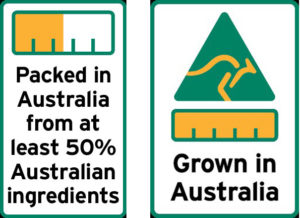Recently, two regulated, voluntary systems were introduced for use on food packaging in Australia to help consumers to make informed choices. However, as good as the intentions of these systems can be, they’ll amount to very little if no one reads or trusts them. That's why we've conducted a survey with over 1,700 South Australians to see what they care about in food labels and were surprised to find a majority one in three felt country of origin was most significant - above nutritional information or ingredients.

Young boy looking up at camera from corner of table while female cuts up tomatoes on chopping board
“Mum, where does food come from?”
Back in the day, we would eat whatever food we could grow or trade with nearby communities. These days, a visit to the supermarket is the food equivalent of travelling around the world.

Abe Simpson probably lived back in the day when you could only eat locally grown food.
But do we Aussies care about where our food has come from?
Absolutely, according to results from a shared cost survey of 1,700 South Australians. In fact, price aside, a majority 35 per cent of participants felt it was the single most important piece of information on a food label.
Our health and biosecurity researcher and co-author of the study, Dr Malcolm Riley, did not anticipate this result.
“I was surprised and I thought more people would be more interested in health issues,’’ he said.
In fact, nutritional information didn’t even manage to rank second most important, with the ingredients list accounting for 21.6 per cent, followed by nutritional information (20.9 per cent) and health claims (4.6 per cent).
It’s perhaps less surprising that consumers tend to trust nutritional information over health claims on packaging.
“They believe the claims are just a trick to sell more food,” Dr Riley explained.
Why do we need to know about what people read?
Recently, two regulated, voluntary systems were introduced for use on food packaging in Australia: the Health Star Rating system and nutrient content and health claims. The intention of these systems is clear: help consumers to make informed choices. However, as good as these systems may be, they’ll amount to very little if no one reads or trusts them.
“In this changing context, consumer attitudes to the various labelling elements that guide their purchasing behaviour and thereby dietary intake are relevant and important for food manufacturers, health practitioners, and government regulators alike,” Dr Riley said.
Can my food call Australia home?
A new country of origin food labelling system for Australia was introduced on July 1, 2016, with compliance required by 1 July 2018. At the present time, country of origin food labelling can meet the mandatory requirements in the Australian Food Standards Code or the new requirements under Australian Consumer Law.
Currently, packaged food must carry a statement of where the food was made, produced or grown; or the country where the food was manufactured or packaged and that the food is a mix of ingredients imported into that country or a mix of local and imported ingredients. The country of origin of the ingredients can also be stated.

The new country of origin food labels
The new food labels will have a kangaroo icon to denote food that was grown, produced or made in Australia, with an origin statement and a bar chart to indicate the percentage of Australian ingredients. For food to be considered to be ‘Made in Australia’, it must be wholly Australian or substantially transformed here – that is, the finished product must be fundamentally different from any of its imported ingredients.
For example, a frozen pecan pie made in Australia from local ingredients and American pecan nuts would be eligible for the new labels because pecan nuts are fundamentally different from a pecan pie. The label for this product would include a kangaroo icon, and a ‘Made in Australia’ statement together with a bar chart and text showing the proportion of Australian content. However, Brazilian orange juice concentrate that is reconstituted and packed in Australia cannot be labelled as ‘Made in Australia’ because reconstituting and packing do not fundamentally change the imported ingredient. Under the new rules, water used to reconstitute a concentrated ingredient takes on the origin of the concentrate. This means the label for this juice would need to indicate that the juice was of Brazilian origin, and if a claim is made that it was packed here, the label would need to include text and a bar chart showing that it contains no Australian ingredients. It would not be eligible to use the kangaroo logo.
Food from multiple countries that is packed in Australia without substantial transformation will be labelled with the statement ‘Packed in Australia’ together with text and a bar chart to indicate the percentage of Australian ingredients (no kangaroo logo). For fully imported foods, the label will clearly show the country of origin, and for most foods, the origin statement will need to be in a clearly defined box to make it easier to find.
For now, food manufacturers can choose to either comply with the existing standards requirement, or to comply with the new country of origin food labelling system.
Did you know we do quite a bit of food research? From storage and nutrition to labelling and diets, find out more about our work here.


10th August 2017 at 5:23 am
Dr Malcolm Riley said really is right
21st January 2017 at 7:07 pm
The labelling should be ONLY for 100% Australian product. ALL countries of origin should be clearly shown.
15th January 2017 at 8:21 am
I am sick of the governments hiding there big cooperate buddy’s selling imported junk
That’s why the labelling has a kangaroo at the 51% mark
It shouldn’t have any kangaroo until 100% and also specify what’s in our fast food that basically is none existent
10th January 2017 at 11:06 pm
I would like to know fully what exactly what foreign ingredients are contained in a product, and the exact percentages. I find it unacceptable to be told that 50% is foreign/Australian.
It is imperative to know the iron content of all products, due to potential for iron loading, especially those fortified with iron.
Pingback: Labels to show where food is grown | Idea Spies